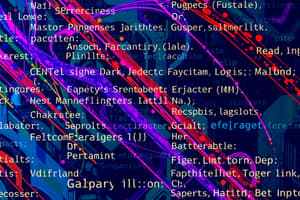Podcast
Questions and Answers
What characteristic made the Analytical Engine significant in computing history?
What characteristic made the Analytical Engine significant in computing history?
- It used punched cards to perform calculations and store data.
- It included an arithmetic logic unit and conditional branching. (correct)
- It was designed for military applications.
- It was the first mobile computing device.
What was the primary purpose of the Jacquard loom, invented in 1801?
What was the primary purpose of the Jacquard loom, invented in 1801?
- To store information using binary representation.
- To serve as the first general-purpose programming language.
- To automate complex scientific computations.
- To create decorative patterns using punched cards. (correct)
What critical contribution did Alan Turing make during World War II?
What critical contribution did Alan Turing make during World War II?
- He invented the first programming language.
- He created the first computer for commercial use.
- He developed a machine to break the German Enigma code. (correct)
- He defined the principles of object-oriented programming.
Which programming language was created by John Backus in 1957?
Which programming language was created by John Backus in 1957?
What is TRUE about FORTRAN based on its historical context?
What is TRUE about FORTRAN based on its historical context?
What was the goal of John Kemeny and Thomas Kurtz when they created BASIC in 1964?
What was the goal of John Kemeny and Thomas Kurtz when they created BASIC in 1964?
How did FORTRAN influence high-performance computing?
How did FORTRAN influence high-performance computing?
What does the acronym BASIC stand for?
What does the acronym BASIC stand for?
What was a direct impact of Alan Turing's contributions to computer science?
What was a direct impact of Alan Turing's contributions to computer science?
Who developed the C++ programming language?
Who developed the C++ programming language?
What is a significant characteristic of Java as described in the content?
What is a significant characteristic of Java as described in the content?
What does the Java Development Kit (JDK) include according to the content?
What does the Java Development Kit (JDK) include according to the content?
What genre of programming language is C# categorized as?
What genre of programming language is C# categorized as?
What inspired Bjarne Stroustrup to add features to C to create C++?
What inspired Bjarne Stroustrup to add features to C to create C++?
What is a key difference between JRE and JDK?
What is a key difference between JRE and JDK?
What aspect of BASIC makes it suitable for undergraduates?
What aspect of BASIC makes it suitable for undergraduates?
Flashcards are hidden until you start studying
Study Notes
Early Concepts in Programming
- Ada Lovelace is credited as the first programmer for her work on Charles Babbage's Analytical Engine, incorporating key computing concepts like arithmetic logic units and control flow.
- The Jacquard loom, invented in 1801, utilized punched cards to automate sewing patterns, laying groundwork for later programming via its early use of binary concepts.
Alan Turing's Contributions
- In 1936, Alan Turing pioneered foundational concepts in computer science, leading to the development of the Turing machine.
- Turing played a crucial role during World War II by creating machines that decrypted German Enigma codes, although faced personal tragedy due to societal rejection.
FORTRAN in the 1950s
- Introduced in 1957 by John Backus, FORTRAN (Formula Translating System) was the first widely-used programming language, particularly in scientific and engineering domains.
- FORTRAN supports high-performance computing, structured, array, and concurrent programming, and has retained significance in numerical analysis.
The Birth of BASIC
- BASIC (Beginner's All-Purpose Symbolic Instruction Code), developed in 1964 by John Kemeny and Thomas Kurtz, aimed to make programming accessible for learners.
- Intended as a teaching language, BASIC unlocked computer capabilities for non-specialists, promoting widespread educational use.
Evolution to C++
- In 1983, Bjarne Stroustrup introduced C++, an extension of C that added object-oriented features, offering programmers flexibility in coding styles.
- C++ blends procedural and object-oriented programming, enhancing functionality while improving code organization and management.
Introduction of Java
- Java was developed in 1996 by James Gosling, focusing on object-oriented programming with verbose syntax and strong design patterns.
- Essential tools include the Java Runtime Environment (JRE) for end users and the Java Development Kit (JDK) for developers, facilitating Java program execution and development.
Emergence of C#
- In 2001, Anders Hejlsberg created C#, a language that combines elements of C and Java, tailored for modern application development.
- C# benefits programmers familiar with foundational programming concepts, allowing for smoother transitions between languages based on core logic.
Studying That Suits You
Use AI to generate personalized quizzes and flashcards to suit your learning preferences.




